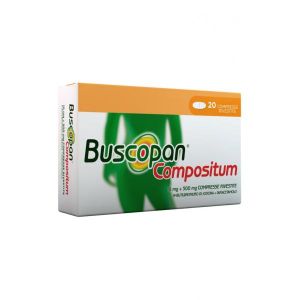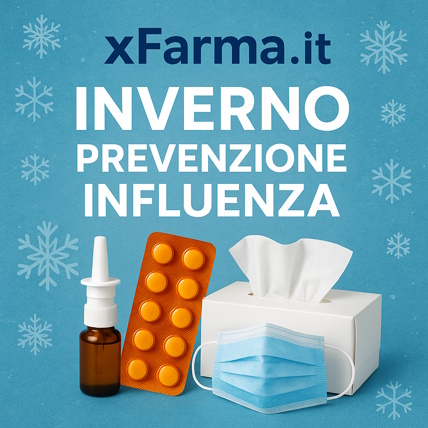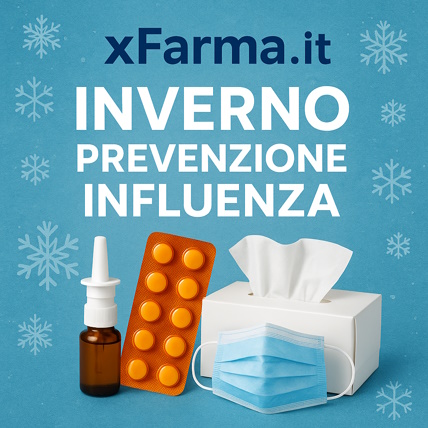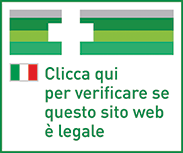Ship in Europe, Find out rates!
Language
Sanofi Buscopan Compositum Food Supplement 20 Coated Tablets

Regular Price
€13.90
Special Price
€11.87
-15%
Save: €2.03
In stock
Recent lowest price:
€11.87
- box Delivery in Italy in 24/48 and free returns
- star3.000+ positive reviews
- dropboxOver 60,000 products in the catalog
Manufacturer
SANOFI
SKU
029454042
Active principle
SCOPOLAMINA BUTILBROMURO/PARACETAMOLO
NAME
BUSCOPAN COMPOSITUM
PHARMACOTHERAPEUTIC CATEGORY
Antispasmodics in combination with analgesics.
ACTIVE PRINCIPLES
Hyoscine N-butylbromide, paracetamol.
EXCIPIENTS
>> Coated tablets. Core: microcrystalline cellulose, carmellosasodium, corn starch, ethylcellulose, colloidal silica, magnesium stearate. Coating: hypromellose, polyacrylates, titanium dioxide, macrogol 6000, talc, silicone-antifoam agent. Suppositories: glyceride esters of saturated fatty acids, soy lecithin.
INDICATIONS
Paroxysmal pains in affections of the gastrointestinal tract, spastic pains, dyskinesias of the urinary and biliary tract, dysmenorrhea.
CONTRAINDICATIONS / SECONDARY EFFECT
Hypersensitivity 'to the active ingredients, to non-steroidal anti-inflammatory drugs or to any of the excipients; acute angle glaucoma; prostatic hypertrophy or other causes of urinary retention; pyloric stenosis and other conditions stenosing the gastrointestinal canal, paralytic ileus, ulcerative colitis, megacolon; reflux esophagitis; intestinal atony of the elderly and debilitated subjects; myasthenia gravis; pediatric age; paracetamol-based products are contraindicated in patients with manifest insufficiency of glucose-6-phosphate dehydrogenase and in those suffering from severe haemolytic anemia; severe hepatocellular insufficiency (Child - Pugh C). The use of the medicine is contraindicated in case of rare hereditary conditions that may be incompatible with an excipient of the product. The drug 10 mg + 800 mg suppositories should not be used in patients with a history of allergy to asosia or peanut.
DOSAGE
The following dosage is recommended for adults, unless otherwise prescribed. Coated tablets: 1-2 tablets 3 times a day. Do not exceed 6 tablets per day. The tablets should not be chewed, but swallowed whole with a sufficient amount of water. Suppositories: 1 suppository 3-4 times a day. Do not exceed 4 suppositories per day. Duration of treatment: the drug should not be taken for more 'than three days unless prescribed by a doctor. Pediatric population: the use of the drug is not recommended in children under 10 years of age. The concomitant administration of other drugs containing paracetamol, may require a dosage adjustment.
STORAGE
Tablets: store below 25 degrees C. Suppositories: store below 30 degrees C.
WARNINGS
The drug should not be taken for more 'than 3 days unless directed by the doctor. Instruct the patient to seek medical attention if the pain persists or worsens, if new symptoms occur, or if redness or swelling develops as these could be symptoms of a serious condition. If severe abdominal pain of unknown origin persists, worsens or is accompanied by symptoms such as fever, nausea, vomiting, abnormal bowel movements, distended abdomen, drop in blood pressure, fainting or blood in stool, seek immediate medical attention. To prevent overdose, it must be ensured that any other drugs taken at the same time do not contain paracetamol, one of the active ingredients of the drug. Liver damage may occur if the recommended dosage for paracetamol is exceeded. The medicinal product should be used with caution in case of: glucose-6-phosphate dehydrogenase insufficiency; liver dysfunction (e.g. due to chronic alcohol abuse, hepatitis); impaired renal function; Gilbert's syndrome; hepatocellular insufficiency (Child-Pugh A / B). Administer with caution in subjects with renal or hepatic insufficiency. In such conditions, the drug should only be administered under medical supervision, if necessary, by reducing the dose or extending the interval between individual administrations. Blood counts and renal and hepatic function should be monitored after prolonged use. The extensive use of analgesics, especially at high doses, can induce headache which should not be treated with increased doses of the drug. Serious acute hypersensitivity reactions (eg anaphylactic shock) are observed very rarely. The treatment must be stopped at the first signs of a hypersensitivity reaction following the administration of the product. Abrupt discontinuation of analgesics after prolonged use at high doses can cause withdrawal symptoms (e.g. headache, fatigue, nervousness), which usually resolve within a few days. Resumption of analgesics should be subject to medical advice and remission of withdrawal symptoms. Due to the potential risk of anticholinergic complications, it should be used with caution in patients predisposed to narrow-angle glaucoma, in patients prone to obstruction of the intestinal or urinary tract and in those prone to tachyarrhythmia with disorders of the autonomic central nervous system, in tachyarrhythmias, in arterial hypertension, congestive heart failure and hyperthyroidism. All antimuscarinics reduce the volume of bronchial secretions; therefore they must be used with caution in subjects with chronic obstructive inflammatory diseases of the respiratory system. During treatment with paracetamol, before taking any other drug, check that it does not contain the same active ingredient, as if paracetamol is taken in high doses, serious adverse reactions may occur. Instruct the patient to contact the physician before combining any other medication. The drug 10 mg + 500 mg tablets contains 4.32 mg of sodium per tablet.
INTERACTIONS
Use with extreme caution and under strict control during chronic treatment with drugs that can determine the induction of hepatic monooxygenases or in case of exposure to substances that can have this effect (for example rifampicin, cimetidine, antiepileptics such as glutethimide, phenobarbital, carbamazepine). The same situation occurs with potentially hepatotoxic substances and with alcohol abuse. Concomitant administration of chloramphenicol can induce a prolongation of the half-life of chloramphenicol, with the risk of elevating its toxicity. Since the clinical relevance of the interactions of paracetamol with warfarin and coumarin derivatives has not yet been ascertained, long-term use of the drug in patients undergoing therapy with oral anticoagulants should only take place under medical supervision. Concomitant use of paracetamol and zidovudine (AZT or retrovir) increases the tendency to shrink leukocytes (neutropenia). Therefore the drug should be taken together with zidovudine only under medical supervision. Intake of probenecid inhibits the binding of paracetamol to glucuronic acid, thereby reducing the clearance of paracetamol by approximately a factor of 2. The dose of paracetamol should therefore be reduced during co-administration with probenecid. Cholestyramine reduces the absorption of paracetamol. The administration of paracetamol can interfere with the determination of uric acid (by the method of phosphotungstic acid) and with that of blood sugar (by the method of glucose-oxidase-peroxidase). The anticholinergic effect of drugs such as tri- and tetracyclic antidepressants, antihistamines, antipsychotics, quinidine, amantadine, disopyramide and other anticholinergics (e.g. tiotropium, ipratropium, atropine-like substances) can be enhanced by the drug. Concomitant treatment with dopamine antagonists, such as metoclopramide, may result in a reduction in the effect of both drugs on the gastrointestinal tract. Tachycardia induced by beta-adrenergic drugs can 'be potentiated by the drug. The tachycardic effects of beta-adrenergic agents can be intensified by the drug. In addition for oral use: drugs that slow down gastric emptying (eg propanteline) can reduce the absorption rate of paracetamol, delaying its therapeutic effect; on the contrary, drugs that increase the gastric emptying rate (eg metoclopramide) lead to an increase in the absorption rate of paracetamol.
SIDE EFFECTS
Adverse reactions are listed below by system organ class and frequency, according to the following categories: very common> = 1/10; common> = 1/100 <1/10; uncommon> = 1 / 1,000 <1/100; rare> = 1 / 10,000 <1 / 1,000; very rare <1 / 10,000; not known. Disorders of the blood and lymphatic system. Not known: pancytopenia, agranulocytosis, thrombocytopenia, leukopenia. Immune system disorders, skin and subcutaneous tissue disorders. Uncommon: skin reactions, abnormal sweating, itching, nausea; rare: erythema, decrease in blood pressure including shock; not known: anaphylactic shock, anaphylactic reactions, skin reaction from drug, dyspnoea, hypersensitivity ', angioedema, urticaria, skin rash, exanthema. Very rare cases of severe skin reactions (such as Stevens-Johnson syndrome (SJS), epidermal necrolysis (TEN), and generalized exanthematous pustulosis (AGEP)) have been reported with the use of paracetamol. Cardiac pathologies. Rare: tachycardia. Respiratory, thoracic and mediastinal disorders. Not known: bronchial muscle spasms (especially in patients with a history of bronchial asthma or allergy). Gastrointestinal disorders. Uncommon: dry mouth. Hepatobiliary disorders. Not known: increased transaminases. Renal and urinary disorders. Not known: urinary retention. Cases of erythema multiforme have been reported with the use of paracetamol. Hypersensitivity reactions have been reported, such as angioedema, edema of the larynx. In addition, the following undesirable effects have been reported: anemia, alterations in liver function and hepatitis, alterations in the kidney (acute renal failure, interstitial nephritis, haematuria, anuria), gastrointestinal reactions and dizziness. Somnolence, mydriasis, accommodation disturbances, increased eye tone, constipation and difficulty in urination have also been reported. The reporting of suspected adverse reactions that occur after the authorization of the drug is important, as it allows continuous monitoring of the benefit / risk ratio of the drug.
PREGNANCY AND BREASTFEEDING
There are no adequate data on the use of the medicine during pregnancy. Long experience with the two substances alone has indicated insufficient evidence of adverse effects during pregnancy in women. After the use of hyoscine N-butylbromide, pre-clinical studies in rats and rabbits showed neither embryotoxic nor teratogenic effects. Potential data on paracetamol overdose during pregnancy did not show an increased risk of malformations. Reproduction studies to investigate oral use have shown no signs suggesting malformations of fetotoxicity. Under normal conditions of use, paracetamol can 'be taken during pregnancy after careful consideration of the risk-benefit ratio. During pregnancy, paracetamol should not be taken for prolonged periods, in high doses, or in combination with other medicines as safety has not been confirmed in such cases. Therefore, the drug is not recommended during pregnancy. The safety of hyoscine N-butylbromide during breastfeeding has not yet been established. Paracetamol is excreted in breast milk. However, it is expected that at therapeutic doses it will not cause undesirable effects in the newborn. The decision to continue or discontinue breastfeeding or to continue or discontinue drug therapy should be made considering the benefits of breastfeeding for the infant and the benefits of drug therapy for the mother. No studies on the effects on fertility in humans have been conducted.
BUSCOPAN COMPOSITUM
PHARMACOTHERAPEUTIC CATEGORY
Antispasmodics in combination with analgesics.
ACTIVE PRINCIPLES
Hyoscine N-butylbromide, paracetamol.
EXCIPIENTS
>> Coated tablets. Core: microcrystalline cellulose, carmellosasodium, corn starch, ethylcellulose, colloidal silica, magnesium stearate. Coating: hypromellose, polyacrylates, titanium dioxide, macrogol 6000, talc, silicone-antifoam agent. Suppositories: glyceride esters of saturated fatty acids, soy lecithin.
INDICATIONS
Paroxysmal pains in affections of the gastrointestinal tract, spastic pains, dyskinesias of the urinary and biliary tract, dysmenorrhea.
CONTRAINDICATIONS / SECONDARY EFFECT
Hypersensitivity 'to the active ingredients, to non-steroidal anti-inflammatory drugs or to any of the excipients; acute angle glaucoma; prostatic hypertrophy or other causes of urinary retention; pyloric stenosis and other conditions stenosing the gastrointestinal canal, paralytic ileus, ulcerative colitis, megacolon; reflux esophagitis; intestinal atony of the elderly and debilitated subjects; myasthenia gravis; pediatric age; paracetamol-based products are contraindicated in patients with manifest insufficiency of glucose-6-phosphate dehydrogenase and in those suffering from severe haemolytic anemia; severe hepatocellular insufficiency (Child - Pugh C). The use of the medicine is contraindicated in case of rare hereditary conditions that may be incompatible with an excipient of the product. The drug 10 mg + 800 mg suppositories should not be used in patients with a history of allergy to asosia or peanut.
DOSAGE
The following dosage is recommended for adults, unless otherwise prescribed. Coated tablets: 1-2 tablets 3 times a day. Do not exceed 6 tablets per day. The tablets should not be chewed, but swallowed whole with a sufficient amount of water. Suppositories: 1 suppository 3-4 times a day. Do not exceed 4 suppositories per day. Duration of treatment: the drug should not be taken for more 'than three days unless prescribed by a doctor. Pediatric population: the use of the drug is not recommended in children under 10 years of age. The concomitant administration of other drugs containing paracetamol, may require a dosage adjustment.
STORAGE
Tablets: store below 25 degrees C. Suppositories: store below 30 degrees C.
WARNINGS
The drug should not be taken for more 'than 3 days unless directed by the doctor. Instruct the patient to seek medical attention if the pain persists or worsens, if new symptoms occur, or if redness or swelling develops as these could be symptoms of a serious condition. If severe abdominal pain of unknown origin persists, worsens or is accompanied by symptoms such as fever, nausea, vomiting, abnormal bowel movements, distended abdomen, drop in blood pressure, fainting or blood in stool, seek immediate medical attention. To prevent overdose, it must be ensured that any other drugs taken at the same time do not contain paracetamol, one of the active ingredients of the drug. Liver damage may occur if the recommended dosage for paracetamol is exceeded. The medicinal product should be used with caution in case of: glucose-6-phosphate dehydrogenase insufficiency; liver dysfunction (e.g. due to chronic alcohol abuse, hepatitis); impaired renal function; Gilbert's syndrome; hepatocellular insufficiency (Child-Pugh A / B). Administer with caution in subjects with renal or hepatic insufficiency. In such conditions, the drug should only be administered under medical supervision, if necessary, by reducing the dose or extending the interval between individual administrations. Blood counts and renal and hepatic function should be monitored after prolonged use. The extensive use of analgesics, especially at high doses, can induce headache which should not be treated with increased doses of the drug. Serious acute hypersensitivity reactions (eg anaphylactic shock) are observed very rarely. The treatment must be stopped at the first signs of a hypersensitivity reaction following the administration of the product. Abrupt discontinuation of analgesics after prolonged use at high doses can cause withdrawal symptoms (e.g. headache, fatigue, nervousness), which usually resolve within a few days. Resumption of analgesics should be subject to medical advice and remission of withdrawal symptoms. Due to the potential risk of anticholinergic complications, it should be used with caution in patients predisposed to narrow-angle glaucoma, in patients prone to obstruction of the intestinal or urinary tract and in those prone to tachyarrhythmia with disorders of the autonomic central nervous system, in tachyarrhythmias, in arterial hypertension, congestive heart failure and hyperthyroidism. All antimuscarinics reduce the volume of bronchial secretions; therefore they must be used with caution in subjects with chronic obstructive inflammatory diseases of the respiratory system. During treatment with paracetamol, before taking any other drug, check that it does not contain the same active ingredient, as if paracetamol is taken in high doses, serious adverse reactions may occur. Instruct the patient to contact the physician before combining any other medication. The drug 10 mg + 500 mg tablets contains 4.32 mg of sodium per tablet.
INTERACTIONS
Use with extreme caution and under strict control during chronic treatment with drugs that can determine the induction of hepatic monooxygenases or in case of exposure to substances that can have this effect (for example rifampicin, cimetidine, antiepileptics such as glutethimide, phenobarbital, carbamazepine). The same situation occurs with potentially hepatotoxic substances and with alcohol abuse. Concomitant administration of chloramphenicol can induce a prolongation of the half-life of chloramphenicol, with the risk of elevating its toxicity. Since the clinical relevance of the interactions of paracetamol with warfarin and coumarin derivatives has not yet been ascertained, long-term use of the drug in patients undergoing therapy with oral anticoagulants should only take place under medical supervision. Concomitant use of paracetamol and zidovudine (AZT or retrovir) increases the tendency to shrink leukocytes (neutropenia). Therefore the drug should be taken together with zidovudine only under medical supervision. Intake of probenecid inhibits the binding of paracetamol to glucuronic acid, thereby reducing the clearance of paracetamol by approximately a factor of 2. The dose of paracetamol should therefore be reduced during co-administration with probenecid. Cholestyramine reduces the absorption of paracetamol. The administration of paracetamol can interfere with the determination of uric acid (by the method of phosphotungstic acid) and with that of blood sugar (by the method of glucose-oxidase-peroxidase). The anticholinergic effect of drugs such as tri- and tetracyclic antidepressants, antihistamines, antipsychotics, quinidine, amantadine, disopyramide and other anticholinergics (e.g. tiotropium, ipratropium, atropine-like substances) can be enhanced by the drug. Concomitant treatment with dopamine antagonists, such as metoclopramide, may result in a reduction in the effect of both drugs on the gastrointestinal tract. Tachycardia induced by beta-adrenergic drugs can 'be potentiated by the drug. The tachycardic effects of beta-adrenergic agents can be intensified by the drug. In addition for oral use: drugs that slow down gastric emptying (eg propanteline) can reduce the absorption rate of paracetamol, delaying its therapeutic effect; on the contrary, drugs that increase the gastric emptying rate (eg metoclopramide) lead to an increase in the absorption rate of paracetamol.
SIDE EFFECTS
Adverse reactions are listed below by system organ class and frequency, according to the following categories: very common> = 1/10; common> = 1/100 <1/10; uncommon> = 1 / 1,000 <1/100; rare> = 1 / 10,000 <1 / 1,000; very rare <1 / 10,000; not known. Disorders of the blood and lymphatic system. Not known: pancytopenia, agranulocytosis, thrombocytopenia, leukopenia. Immune system disorders, skin and subcutaneous tissue disorders. Uncommon: skin reactions, abnormal sweating, itching, nausea; rare: erythema, decrease in blood pressure including shock; not known: anaphylactic shock, anaphylactic reactions, skin reaction from drug, dyspnoea, hypersensitivity ', angioedema, urticaria, skin rash, exanthema. Very rare cases of severe skin reactions (such as Stevens-Johnson syndrome (SJS), epidermal necrolysis (TEN), and generalized exanthematous pustulosis (AGEP)) have been reported with the use of paracetamol. Cardiac pathologies. Rare: tachycardia. Respiratory, thoracic and mediastinal disorders. Not known: bronchial muscle spasms (especially in patients with a history of bronchial asthma or allergy). Gastrointestinal disorders. Uncommon: dry mouth. Hepatobiliary disorders. Not known: increased transaminases. Renal and urinary disorders. Not known: urinary retention. Cases of erythema multiforme have been reported with the use of paracetamol. Hypersensitivity reactions have been reported, such as angioedema, edema of the larynx. In addition, the following undesirable effects have been reported: anemia, alterations in liver function and hepatitis, alterations in the kidney (acute renal failure, interstitial nephritis, haematuria, anuria), gastrointestinal reactions and dizziness. Somnolence, mydriasis, accommodation disturbances, increased eye tone, constipation and difficulty in urination have also been reported. The reporting of suspected adverse reactions that occur after the authorization of the drug is important, as it allows continuous monitoring of the benefit / risk ratio of the drug.
PREGNANCY AND BREASTFEEDING
There are no adequate data on the use of the medicine during pregnancy. Long experience with the two substances alone has indicated insufficient evidence of adverse effects during pregnancy in women. After the use of hyoscine N-butylbromide, pre-clinical studies in rats and rabbits showed neither embryotoxic nor teratogenic effects. Potential data on paracetamol overdose during pregnancy did not show an increased risk of malformations. Reproduction studies to investigate oral use have shown no signs suggesting malformations of fetotoxicity. Under normal conditions of use, paracetamol can 'be taken during pregnancy after careful consideration of the risk-benefit ratio. During pregnancy, paracetamol should not be taken for prolonged periods, in high doses, or in combination with other medicines as safety has not been confirmed in such cases. Therefore, the drug is not recommended during pregnancy. The safety of hyoscine N-butylbromide during breastfeeding has not yet been established. Paracetamol is excreted in breast milk. However, it is expected that at therapeutic doses it will not cause undesirable effects in the newborn. The decision to continue or discontinue breastfeeding or to continue or discontinue drug therapy should be made considering the benefits of breastfeeding for the infant and the benefits of drug therapy for the mother. No studies on the effects on fertility in humans have been conducted.
| Destination | Cost | Detail |
|---|---|---|
| Italy | €5,90* | 24/72H |
| Austria, France, Germany, Slovenia | € 13* | 3 days |
| Belgium, Luxembourg, Portugal, Netherlands, Spain | € 14* | 4 days |
| Bulgary, Cechia, Hungary, Poland, Romania, Slovakia | € 19* | 5 days |
| Denmark, Estonia, Finland, Ireland, Lithuania, Latvia ,Sweden | € 22* | 5 days |
| United Kingdom, Switzerland, Greece, Malta/td> | € 30* | 7 days |
| Canada | € 40 | 7 Days |
European shipments with express courier: FedEx, MBE, DHL
*For the shipment outside band B ther's an extra cost of 22€ *For the shipment outside band C ther's an extra cost of 30€ Delivery Times exclude Saturday and Holidays
For Islands and Areas of difficult Accessibility the shipments are made in 72 hours and the cost will be increased by 15€
The images of the products shown on our site are purely indicative and may differ in shape, color, text and packaging shown on them. Given the difficulty of updating all the products on our site in real time or any errors, XFarma.it, all products will be identified through SKU MINSAN (code of the Ministry of Health).


